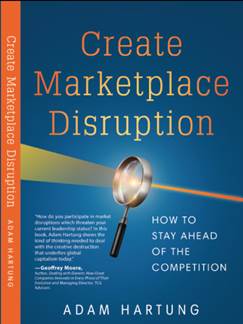The newsletters of Adam Hartung.
Keynote Speaker, Managing Partner, Author on Trends

White Space Innovation on Demand
 In economic terms, there’s an oversupply of news. People are stressed and overwhelmed. With all that’s going on in the world right now, how can you keep your business and employees on track for profitable growth?
In economic terms, there’s an oversupply of news. People are stressed and overwhelmed. With all that’s going on in the world right now, how can you keep your business and employees on track for profitable growth? Balance will soon return and the winners will be the businesses that stay focused on key trends and new product activities. They will continue to create innovation gaps on the lifecycle. The question is: can you maintain your team’s focus on innovation and customer needs?
Dedication to a single purpose
Start-ups are an example of businesses groups dedicated to a single purpose and, failing fast, can pivot on a dime to move toward a viable new product. They aren’t easily distracted. I’ve written at length about how too often new products, and innovation, in established companies are crushed by status quo forces. Progressive companies have learned to avoid those problems and achieve the benefits of an undistracted, focused start-up team.
Years ago, companies attempted to centralize innovation – like DuPont’s central research and development department including The Experimental Station; or Xerox’s Palo Alto Research Center (PARC.) Many large corporations had some success, but they still encountered the negative forces of the status quo that blocked innovations with their focus on current operations.
This evolved toward universities like Northwestern, Harvard, Iowa State, Michigan State, etc. creating innovation centers where professors and students could experiment with new commercial ideas in a venture environment connected to the business community.
Incubators are Born

Chicago 1871 Incubator
>More recently organizations have imitated the university idea and avoided the status quo hurdles by combining old and new models. In facilities made legendary by Lockheed and IBM, major companies created small, separate divisions to foster innovation. They were originally called “Skunkworks” (after a tanning company in the cartoon, “Lil Abner” in the 1940s,) but today, they are called by the less odiferous name of: Incubators.
Popular with most large cities by 2012, (e.g. “1871” in Chicago,) corporations developed their own partnerships and now benefit in several ways. Here are a few examples:
| Company | Accelerator |
|---|---|
| Bayer AG | Grants4Apps Accelerator |
| Coca Cola | The Bridge |
| Johnson and Johnson | JLabs |
| Lowe’s Companies, Inc. | Lowe’s Accelerator |
| Telefonica | Open Future |
 Today, corporations can outsource innovation and white space projects while employees focus on current operations. They can operate almost as stand-alone venture funding departments. The larger status quo focused employee groups are not distracted, and can focus on cost and sustaining innovations while White Space projects are developed in incubators. The obvious benefit is a flow of new product ideas which can lead to financial success if the business succeeds – but the risks (and costs) are kept low. The financial risk is low because the facility can be scaled up or down, and the risk to the existing brand is low because it is separated.
Today, corporations can outsource innovation and white space projects while employees focus on current operations. They can operate almost as stand-alone venture funding departments. The larger status quo focused employee groups are not distracted, and can focus on cost and sustaining innovations while White Space projects are developed in incubators. The obvious benefit is a flow of new product ideas which can lead to financial success if the business succeeds – but the risks (and costs) are kept low. The financial risk is low because the facility can be scaled up or down, and the risk to the existing brand is low because it is separated.
Using concepts like the “New Product Process” from PDMA and strategic guidance from dedicated, innovation oriented corporate leadership or trained consultants, projects for Incubators are evaluated independent of the status quo. There is freedom to experiment and to fail. And incubators can leverage nearby college campuses to tap into the knowledge of academicians and the creative energy of students – without the burden of big corporate contracts defining relationships that slow innovation and market development.
Add me to email list!
“Yes, risk-taking is inherently failure-prone. Otherwise, it would be called ‘sure-thing-taking’.”
Jim McMahon
Quarterback, Chicago Bears
Actions you can take
Interested in joining an incubator in your area? Contact local universities to identify a list of incubators or start-up centers. Local community colleges often have relationships and even host local advisory groups.
Click here for a list of more international business incubators.
How we can help
Let us work with you to define the sort of project that makes sense, and link to the kind of incubator likely to achieve results. Let us help you define the goals, investment and review metrics to launch a project. And we’ll help you develop the best contracts for working relationships with other incubator resources, universities and other potential corporate partners – or start-up partners. Our experience in innovation management, coupled with the capabilities of an incubator could help you put in place the White Space you need to focus on growth in today’s highly distracted world.We are your experts at identifying trends, creating scenarios and building monitoring systems.
We’ve done this kind of work for over 20 years, and bring a wealth of experience, and tools, to the task. You don’t have to go into scenario planning alone; we can be your coach and mentor to speed learning, and success.
For more on how to include trends in your planning, I’ve created a “how-to” that you can adapt for your team. See my Status Quo Risk Management Playbook.
Give us a call today, or send an email, so we can talk about how you can be a leader, rather than follower, in 2017 and beyond. Or check out the rest of the website to read up on what we do so we can create the right level of engagement for you.



